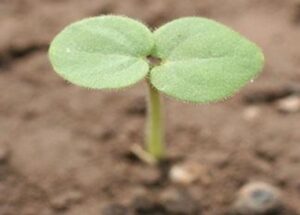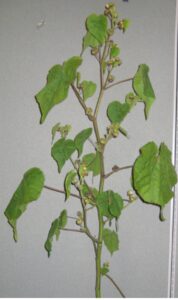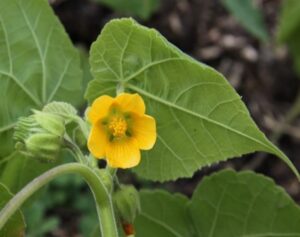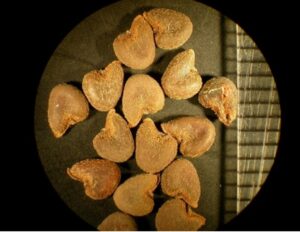Velvetleaf (Abutilon theophrasti) – Mallow Family
Synonyms: pie marker, buttonweed, Indian mallow, butter print, velvet weed, butter-weed, Indian hemp, cotton-weed, and wild cotton.
Identification and General Description
- Summer annual that grows 3 to 8 feet tall.
- Heart-shaped leaves and stems are covered with short, soft hairs giving it a velvety feel.
- Young leaves and stems emit an unpleasant odor when crushed.
- When mature, leaves are alternate.
- Fibrous root system with a shallow taproot.
- Yellow to yellow-orange flowers with five petals form on the upper branches.
- Plants flower from July through September.
- Each flower includes many stamens which fuse to form a tube.
- Spreads by seed and is self-fertile.
- Seed capsules are circular cluster of 12 to 15 seedpods, ½ to 1 inch long.
- One plant can produce up to 17,000 heart-shaped seeds.
- Seeds can remain viable in the soil for up to 50 years.

Figure 1. Velvetleaf seedling with heart-shaped and hairy seed leaves. (Photo by University of Missouri)
Impacts/ Why is it important to know?
- Common in horticulture and agronomic crops.
- Contains chemicals that inhibit germination of some crop seeds.
- Competes well for water, light and soil nutrients.
- Can host insects and disease organisms harmful to crops.

Figure 4. Velvetleaf can grow up to 1.5 meters tall and completely covered in soft hairs. (Photo by King county, WA)
Control Methods/ What can you do?
- Preventing seed introduction by using tested seed and removing visible soil from tractors and implements prior to entering velvetleaf-free fields.
- If small infestations occur or escape treatment, rogue plants before they set seed.
- Mowing can be effective only when plants are still small.
- Plowing or tilling aids in velvetleaf seed germination. This can be exploited to promote germination in fields that are left fallow. Once seedlings emerge and are small, implement a post-emergence control (herbicide, tillage, flaming). Repeat to encourage successive flushes.
- Rotate to crops that have more effective, registered herbicides.
- Non-selective herbicides, such as glyphosate, can be effective. Use shielded or directed applications to keep non-selective herbicides from contacting the crop.
- Herbicides containing 2,4-D can be effective, but have limited uses in vegetables.
- Herbicide applications to emerged weeds should be applied before weeds are 4 inches for optimum results.
See the Midwest Vegetable Production Guide for more information about how to control major weeds including velvetleaf, in most vegetable crops.
Order the printed Midwest Vegetable Production Guide here:
Use the searchable online Midwest Vegetable Production Guide here: https://mwveguide.org/
References
Spencer, N., 1984. Velvet leaf, abutilon theophrasti (Malvaceae), history and economic impact in the United States. Economic Botany 387 (4), 407 – 416.
Uva, R.; Neal, J.; and DiTomaso, J., 1997. Weeds of the Northeast. Cornell University Press, Ithaca, (NY) – 14850. p 256. ISBN 0801433916

